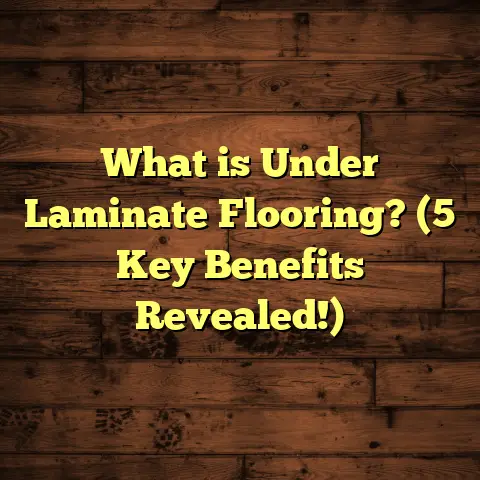What is Tile vs. Laminate Flooring? (5 Key Differences Explained)
Eco-Conscious Choices and Flooring: Why It Matters to Me
When I was renovating my home, one of my top priorities was making eco-conscious
choices. Flooring is such a big part of any room and a major decision in terms of
both aesthetics and environmental impact. I asked myself, “How can I pick flooring
that looks great, lasts, and aligns with my values around sustainability?”
Tile and laminate flooring were two popular options that kept coming up. Each has its
own strengths and weaknesses, but I quickly realized they are quite different in terms
of durability, installation, cost, maintenance, and environmental footprint.
Over the years working in home renovations and flooring installations, I’ve learned a lot
about both. I want to share what I’ve discovered by comparing tile versus laminate flooring
across five key areas. Hopefully, after reading this, you’ll have a clearer picture of which
might be right for your home—and maybe save yourself some stress or costly mistakes.
What Is Tile Flooring and Laminate Flooring?
Understanding the basics first always helps. So, what exactly are tile and laminate flooring?
Tile Flooring: A Classic Choice
Tile flooring typically refers to ceramic or porcelain tiles, but also includes natural stone varieties like marble, granite, or slate.
Ceramic and Porcelain Tiles
These types of tile start with natural clay mixed with minerals like quartz and feldspar. The mixture is shaped into tiles either by pressing or extrusion.
The crucial step is firing the tiles in a kiln at very high temperatures—usually between 1,200°C and 1,400°C (about 2,200°F to 2,550°F). This firing vitrifies the clay, turning it into a hard, dense material that resists moisture and wear.
Porcelain is technically a type of ceramic tile made from finer clay and fired at even higher temperatures. Because of this, porcelain tiles are denser, less porous, and generally stronger than standard ceramic tiles.
Natural Stone Tiles
Stone tiles are cut directly from quarries and then polished or honed to achieve the desired finish. They’re prized for their natural beauty but can require more maintenance due to porosity.
Tile is favored for areas prone to moisture—bathrooms, kitchens, entryways—and places where durability is essential.
Laminate Flooring: The Engineered Lookalike
Laminate flooring offers a different approach. Instead of being made from stone or ceramic, it’s a synthetic product designed to mimic natural materials like wood or stone.
The core of laminate flooring is typically made from high-density fiberboard (HDF) or medium-density fiberboard (MDF). These are engineered wood products made by compressing wood fibers with adhesives.
On top of this core is a photographic layer that replicates the look of hardwood grain, stone patterns, or even tiles. This printed design is then covered by a clear wear layer made of melamine resin. This wear layer protects against scratches, fading from sunlight, and general wear.
Laminate floors usually install as floating floors. That means the planks snap together with tongue-and-groove joints without needing glue or nails. This makes installation faster and more accessible for DIYers.
1. Durability and Wear Resistance: How Long Will It Last?
One of the first questions I ask clients is: How much traffic do you expect? Do you have kids or pets? Or maybe you want something that can take spills and still look good.
Tile’s Built-to-Last Nature
Tile floors are incredibly durable. Porcelain tiles especially can endure heavy foot traffic in commercial spaces for decades with little wear.
The firing process creates a vitrified surface that resists scratches and stains. Tiles don’t absorb water much—porcelain usually absorbs less than 0.5%—making them perfect for bathrooms or kitchens where spills happen often.
I remember installing porcelain tile in my own kitchen about 10 years ago. Even with daily cooking chaos and kids dropping food constantly, the floor still looks as good as the day I laid it down.
Mohs Hardness Scale
Tile hardness can be measured on the Mohs scale—porcelain tiles typically rate around 7 (on a scale of 1 to 10), making them harder than many household items that might scratch them.
Laminate’s Tough Exterior but Vulnerable Core
Laminate’s wear layer offers good scratch resistance—often rated between AC3 and AC5 according to industry standards (with AC5 being suitable for heavy commercial use). However, laminate doesn’t handle moisture well because the wood fiber core can swell if water penetrates through edges or damaged areas.
In my experience installing laminate in a basement once, improper moisture control caused some planks to warp after floods. That taught me how important it is to use moisture barriers under laminate floors in damp environments.
Laminate is great for moderate traffic areas like bedrooms or living rooms but may not hold up as well in wet zones.
2. Installation Process: What’s Involved?
How much time and effort are you willing to spend on installation? This is something I always ask myself before starting any flooring project.
Tile Installation: A Step-by-Step Undertaking
Installing tile is not something you want to rush.
It starts with ensuring your subfloor is perfectly level and structurally sound—any unevenness can cause tiles to crack later on.
Next comes spreading a layer of thinset mortar using a notched trowel. Tiles get carefully placed over this adhesive with spacers between each piece to keep uniform gaps for grout.
Once mortar cures (which takes about 24 hours), grout fills these spaces to seal the floor against moisture and debris.
Finally, grout lines may be sealed with special sealants to prevent staining over time.
Time Commitment: From prep to finishing grout sealing can take several days for an average room due to drying times between steps.
Laminate Installation: Quick and User-Friendly
Laminate floors usually come in planks with tongue-and-groove edges that click together. These planks float over your existing subfloor or underlayment without glue or nails.
I love this because it lets me install floors quickly—even over old vinyl or wood floors—without messy adhesives or long waits for curing.
A typical installation can be completed in a day or two depending on room size.
Pro Tip: Use an underlayment designed for soundproofing and moisture protection to enhance comfort and floor longevity.
3. Cost Considerations: What’s Your Budget Saying?
Money talks loud when planning any home improvement project.
Material Costs
Tile prices vary widely:
- Ceramic tiles: $1 – $15 per square foot
- Porcelain tiles: $3 – $20 per square foot
- Natural stone tiles: $10 – $30+ per square foot
Laminate flooring tends to be more affordable upfront:
- Laminate: $1.50 – $6 per square foot depending on quality
Installation Costs
Tile installation requires skilled labor due to its complexity:
- Labor costs may match or exceed material costs.
- Total tile installation can range from $7 – $25 per square foot including labor.
Laminate installation is less costly:
- Labor costs are lower because installation is straightforward.
- Some homeowners DIY laminate to save money entirely.
- Typical installation ranges $2 – $8 per square foot with labor included.
How I Use FloorTally To Manage Costs
When juggling multiple projects with different flooring types, I rely on tools like FloorTally to get accurate estimates quickly. It factors in local labor rates, waste percentages (important for tile cutting), and material options side-by-side.
This helps me avoid surprises after ordering materials or hiring installers. It’s saved me thousands over time by letting me compare scenarios efficiently.
4. Maintenance and Lifespan: Keeping Floors Looking Great
What happens after installation? Floors need care if you want them to last.
Tile Maintenance: Simple but Important
Tiles themselves are low-maintenance:
- Sweep or vacuum regularly to remove dirt.
- Mop with mild detergent.
- Avoid harsh chemicals that could damage grout or glaze.
- Re-seal grout lines every few years depending on wear.
I once helped a friend whose grout lines had darkened significantly after 8 years without sealing—the difference after professional cleaning and sealing was dramatic!
Laminate Maintenance: Handle With Care
Laminate floors should be cleaned with damp mops—not soaked—to avoid water damage.
Avoid abrasive cleaners or steel wool that could scratch the wear layer.
If scratches appear over time, some brands offer repair kits or replacement planks for patching small damaged areas.
Lifespan Comparison
With proper maintenance:
- Tile floors can last 30+ years.
- Laminate tends to last 10-20 years before needing replacement due to wear or water damage.
5. Environmental Impact: What’s Greener?
I’m passionate about sustainability so let’s dig into this one carefully.
Tile’s Environmental Footprint
Tile production consumes significant energy during kiln firing at extreme temperatures. This means higher initial carbon emissions during manufacturing.
However:
- Tiles last decades without replacement.
- Made mostly from natural materials.
- Many tile manufacturers now use recycled content.
- Tiles don’t off-gas VOCs making them healthier indoors.
A lifecycle assessment study I reviewed showed that over a 50-year period, tile’s durability offsets its upfront energy cost compared to materials needing frequent replacement.
Laminate’s Sustainability Profile
Laminate uses engineered wood products that often include recycled fibers but also adhesives containing plastics/resins.
Manufacturing uses less heat energy than tile kilns but may involve VOC emissions (though many modern brands use low-VOC adhesives).
Laminate floors don’t last as long so replacement cycles increase material consumption overall.
Technical Specs & Manufacturing Processes Behind The Scenes
Let me share some details about how these products come together because it influences quality and performance you get at home.
How Tile is Made
- Raw Materials: Clay mixed with sand & feldspar.
- Forming: Pressed into shape via molds.
- Drying: Air-dried slowly.
- Glazing: Optional glassy coating applied.
- Firing: Kiln fired at high temps vitrifies the tile.
- Inspection: Checked for defects.
- Cutting/Polishing: Final shaping done before packaging.
Porcelain tiles use finer clays & longer firing cycles for extra strength & low porosity.
How Laminate is Made
- Core Board Creation: Wood fibers compressed into HDF/MDF panels.
- Printing: High-res images printed on decorative paper.
- Overlay Application: Transparent melamine resin added for durability.
- Pressing: Layers bonded under heat & pressure.
- Cutting/Profiling: Boards cut into planks with interlocking edges.
- Surface Texturing: Embossed grain finishes added for realism.
Real-Life Case Studies From My Projects
Let me share some stories from real jobs I worked on that show these differences in action:
Case Study 1: Kitchen Renovation with Porcelain Tile
A client wanted a durable floor for their busy kitchen with kids & pets running around constantly spilling food & liquids. We chose porcelain tiles because:
- Water resistance was critical.
- The client wanted something easy to clean.
- They were okay investing more upfront for long-term durability.
Result: After 5 years, the floor still looks pristine with minimal maintenance needed beyond regular mopping.
Case Study 2: Living Room Makeover Using Laminate
Another client preferred warm wood-like flooring but had budget constraints. We installed high-quality laminate planks with an underlayment for soundproofing.
Benefits:
- Fast installation done over existing vinyl floor.
- Affordable pricing allowed upgrading other parts of the room too.
Drawbacks:
- After 7 years minor scratches appeared in high traffic zones.
- Client plans replacement soon but was happy with performance for the price point.
Additional Tips From My Experience
Here are some things I’ve learned that might help if you’re deciding between tile vs laminate:
- Consider Room Use: Wet areas = tile; dry bedrooms = laminate often better choice.
- Subfloor Prep Is Key: Uneven subfloors cause problems no matter what flooring you choose.
- Moisture Barriers Matter: Especially under laminate in basements or kitchens.
- Test Samples: Bring home samples of both materials under your lighting before deciding.
- Think Long-Term: Factor in maintenance costs & lifespan beyond initial price tag.
- Work With Pros When Needed: Tile installation is a skilled trade worth paying for quality work.
FAQs About Tile vs Laminate Flooring
Q: Can laminate mimic tile look?
A: Yes! Many laminates now have patterns resembling stone or tiles. But texture will differ—tile feels cooler and harder underfoot than laminate’s softer feel.
Q: Is tile cold?
A: Tile can feel cold especially in winter unless you have radiant heating underneath.
Q: Which flooring is easier to repair?
A: Laminate planks can be replaced individually if damaged; tile repairs require removing grout & sometimes breaking tiles which is more involved.
Q: How do I reduce waste when installing tile?
A: Use tools like FloorTally that include waste factors in estimates so you order just enough extra material for cuts without overspending.
Final Thoughts From Me
Choosing between tile and laminate isn’t just picking a style—it’s about matching the floor’s properties
to your lifestyle, budget, environment, and long-term goals.
I encourage you to weigh these five differences carefully based on your priorities:
- Durability & Wear Resistance
- Installation Effort
- Cost Factors
- Maintenance & Lifespan
- Environmental Impact
Whatever you decide, having good information upfront can make all the difference between loving your floors
and regretting them down the road.
And remember tools like FloorTally can make managing costs easy so you spend less time worrying about budgets
and more time enjoying your beautiful new floors!
If you want more tips or have questions about your specific project—just ask! I’m always happy to share what I’ve learned firsthand working across many homes and styles over the years.





